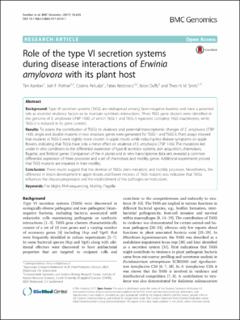Please use this identifier to cite or link to this item:
https://doi.org/10.21256/zhaw-1461| Publication type: | Article in scientific journal |
| Type of review: | Peer review (publication) |
| Title: | Role of the type VI secretion systems during disease interactions of Erwinia amylovora with its plant host |
| Authors: | Kamber, Tim Pothier, Joël Pelludat, Cosima Rezzonico, Fabio Duffy, Brion Smits, Theo |
| DOI: | 10.21256/zhaw-1461 10.1186/s12864-017-4010-1 |
| Published in: | BMC Genomics |
| Volume(Issue): | 16 |
| Issue: | 628 |
| Page(s): | 1 |
| Pages to: | 12 |
| Issue Date: | 17-Aug-2017 |
| Publisher / Ed. Institution: | BioMed Central |
| Publisher / Ed. Institution: | London |
| ISSN: | 1471-2164 |
| Language: | English |
| Subjects: | Fire blight; RNA-sequencing; Motility; Flagella |
| Subject (DDC): | 570: Biology |
| Abstract: | Background: Type VI secretion systems (T6SS) are widespread among Gram-negative bacteria and have a potential role as essential virulence factors or to maintain symbiotic interactions. Three T6SS gene clusters were identified in the genome of E. amylovora CFBP 1430, of which T6SS-1 and T6SS-3 represent complete T6SS machineries, while T6SS-2 is reduced in its gene content. Results: To assess the contribution of T6SSs to virulence and potential transcriptomic changes of E. amylovora CFBP 1430, single and double mutants in two structural genes were generated for T6SS-1 and T6SS-3. Plant assays showed that mutants in T6SS-3 were slightly more virulent in apple shoots while inducing less disease symptoms on apple flowers, indicating that T6SSs have only a minor effect on virulence of E. amylovora CFBP 1430. The mutations led under in vitro conditions to the differential expression of type III secretion systems, iron acquisition, chemotaxis, flagellar, and fimbrial genes. Comparison of the in planta and in vitro transcriptome data sets revealed a common differential expression of three processes and a set of chemotaxis and motility genes. Additional experiments proved that T6SS mutants are impaired in their motility. Conclusion: These results suggest that the deletion of T6SSs alters metabolic and motility processes. Nevertheless, the difference in lesion development in apple shoots and flower necrosis of T6SS mutants was indicative that T6SSs influences the disease progression and the establishment of the pathogen on host plants. |
| URI: | https://digitalcollection.zhaw.ch/handle/11475/1557 |
| Fulltext version: | Published version |
| License (according to publishing contract): | CC BY 4.0: Attribution 4.0 International |
| Departement: | Life Sciences and Facility Management |
| Organisational Unit: | Institute of Natural Resource Sciences (IUNR) |
| Published as part of the ZHAW project: | Genomik und Transkriptomik von Erwinia und Pantoea |
| Appears in collections: | Publikationen Life Sciences und Facility Management |
Files in This Item:
| File | Description | Size | Format | |
|---|---|---|---|---|
| 2017_Kamber_Role of the type VI secretion systems_BMC Genomics.pdf | 913.16 kB | Adobe PDF |  View/Open |
Show full item record
Kamber, T., Pothier, J., Pelludat, C., Rezzonico, F., Duffy, B., & Smits, T. (2017). Role of the type VI secretion systems during disease interactions of Erwinia amylovora with its plant host. BMC Genomics, 16(628), 1–12. https://doi.org/10.21256/zhaw-1461
Kamber, T. et al. (2017) ‘Role of the type VI secretion systems during disease interactions of Erwinia amylovora with its plant host’, BMC Genomics, 16(628), pp. 1–12. Available at: https://doi.org/10.21256/zhaw-1461.
T. Kamber, J. Pothier, C. Pelludat, F. Rezzonico, B. Duffy, and T. Smits, “Role of the type VI secretion systems during disease interactions of Erwinia amylovora with its plant host,” BMC Genomics, vol. 16, no. 628, pp. 1–12, Aug. 2017, doi: 10.21256/zhaw-1461.
KAMBER, Tim, Joël POTHIER, Cosima PELLUDAT, Fabio REZZONICO, Brion DUFFY und Theo SMITS, 2017. Role of the type VI secretion systems during disease interactions of Erwinia amylovora with its plant host. BMC Genomics. 17 August 2017. Bd. 16, Nr. 628, S. 1–12. DOI 10.21256/zhaw-1461
Kamber, Tim, Joël Pothier, Cosima Pelludat, Fabio Rezzonico, Brion Duffy, and Theo Smits. 2017. “Role of the Type VI Secretion Systems during Disease Interactions of Erwinia Amylovora with Its Plant Host.” BMC Genomics 16 (628): 1–12. https://doi.org/10.21256/zhaw-1461.
Kamber, Tim, et al. “Role of the Type VI Secretion Systems during Disease Interactions of Erwinia Amylovora with Its Plant Host.” BMC Genomics, vol. 16, no. 628, Aug. 2017, pp. 1–12, https://doi.org/10.21256/zhaw-1461.
Items in DSpace are protected by copyright, with all rights reserved, unless otherwise indicated.